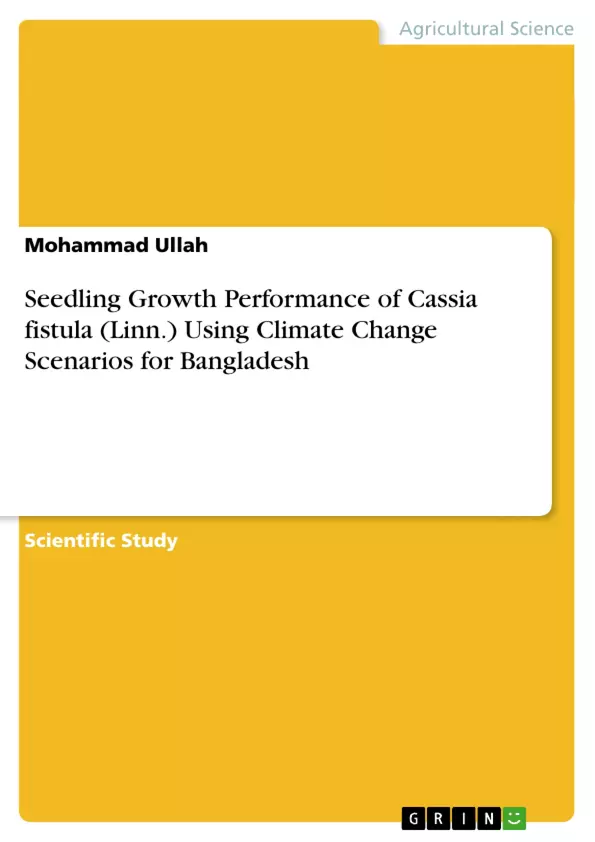Abstract
Climate is a key factor which determines the distribution of plants and animals. The time has come to identify the indigenous and/or exotic forest tree species considering nationally viable and adaptable to future climate change. A need may exist to develop the management techniques with experimental settings to facilitate the survival and make best use of suitable species as well. The aim of the study was to assess the early growth performance of Cassia fistula using Climate change scenarios for Bangladesh. The experiment was conducted in the nursery and tree propagation laboratory of Institute of Forestry and Environmental Sciences, University of Chittagong, Bangladesh from April 2008 to June 2008.
The experiment was conducted under existing temperature; low, mid and high temperature scenarios. The highest average height (13.05 cm) and collar diameter (1.53 cm) of Cassia fistula was found in low temperature scenario followed by existing temperature; mid and high temperature scenarios respectively. Also, average leaf number (21) was developed in low temperature scenario followed by existing (11); high (4) and mid (3) temperature scenarios respectively. The indigenous forest tree species of Bangladesh Cassia fistula may not survive in the natural forest when the temperature of Bangladesh will be rise and the species will go to vulnerable to extinct condition.
Inhaltsverzeichnis (Table of Contents)
- Abstract
- Introduction
- Materials and methods
- Results and discussion
- Conclusion
Zielsetzung und Themenschwerpunkte (Objectives and Key Themes)
This study examines the early growth performance of Cassia fistula seedlings under various temperature scenarios, simulating potential future climate change conditions in Bangladesh. The research aims to assess the species' resilience and potential for adaptation to a warming climate, providing insights into its suitability for forestry activities.
- Climate change impact on tree growth
- Early growth performance of Cassia fistula
- Temperature scenarios and seedling response
- Future implications for forestry in Bangladesh
- Species suitability and vulnerability under climate change
Zusammenfassung der Kapitel (Chapter Summaries)
- Abstract: This section provides a concise summary of the study's purpose, methodology, and key findings related to the impact of climate change scenarios on the early growth performance of Cassia fistula seedlings in Bangladesh.
- Introduction: This chapter introduces Cassia fistula, its distribution, and importance in the region. It also highlights the growing concern over climate change and its potential impact on forestry practices. The chapter discusses projected climate change scenarios for Bangladesh, focusing on temperature and precipitation variations.
- Materials and methods: This section describes the experimental setup and methodology employed in the study. It outlines the use of temperature-controlled growth chambers to simulate different climate scenarios and details the parameters measured to assess seedling growth, including height, collar diameter, and leaf number.
- Results and discussion: This chapter presents the findings of the experiment, comparing the growth performance of Cassia fistula seedlings under various temperature scenarios. The results highlight significant differences in growth attributes, emphasizing the species' sensitivity to rising temperatures.
Schlüsselwörter (Keywords)
Cassia fistula, climate change, temperature scenarios, seedling growth, forestry, Bangladesh, adaptation, vulnerability.
- Quote paper
- Student, M.S. in Forestry Mohammad Ullah (Author), 2008, Seedling Growth Performance of Cassia fistula (Linn.) Using Climate Change Scenarios for Bangladesh , Munich, GRIN Verlag, https://www.grin.com/document/115832



